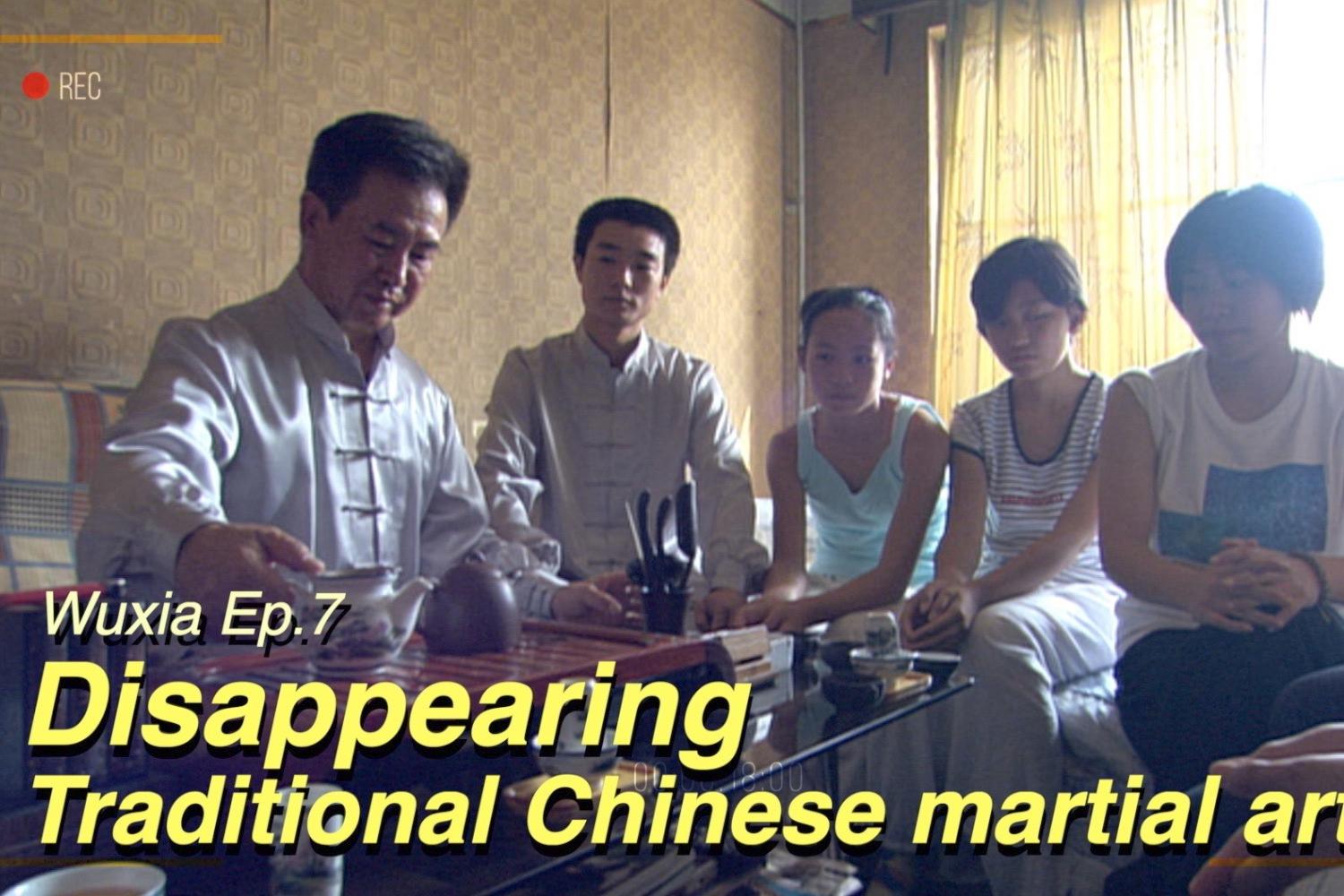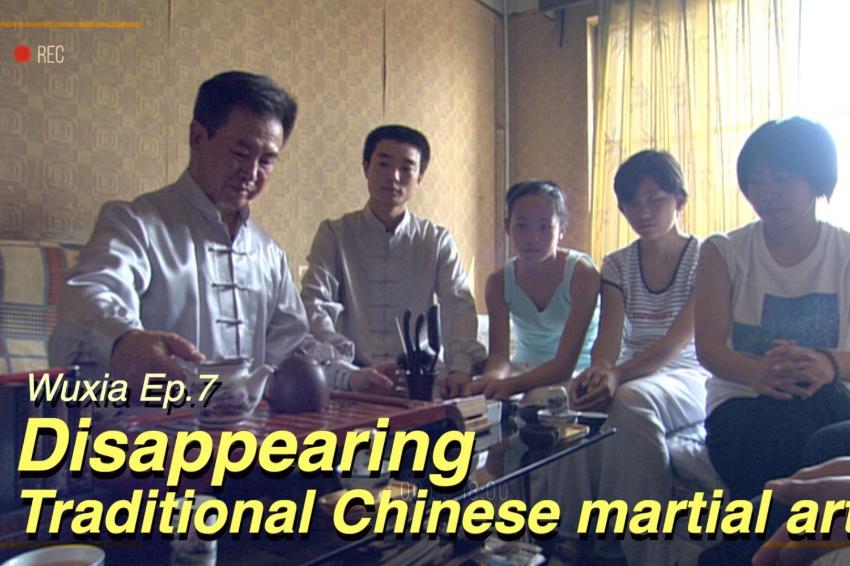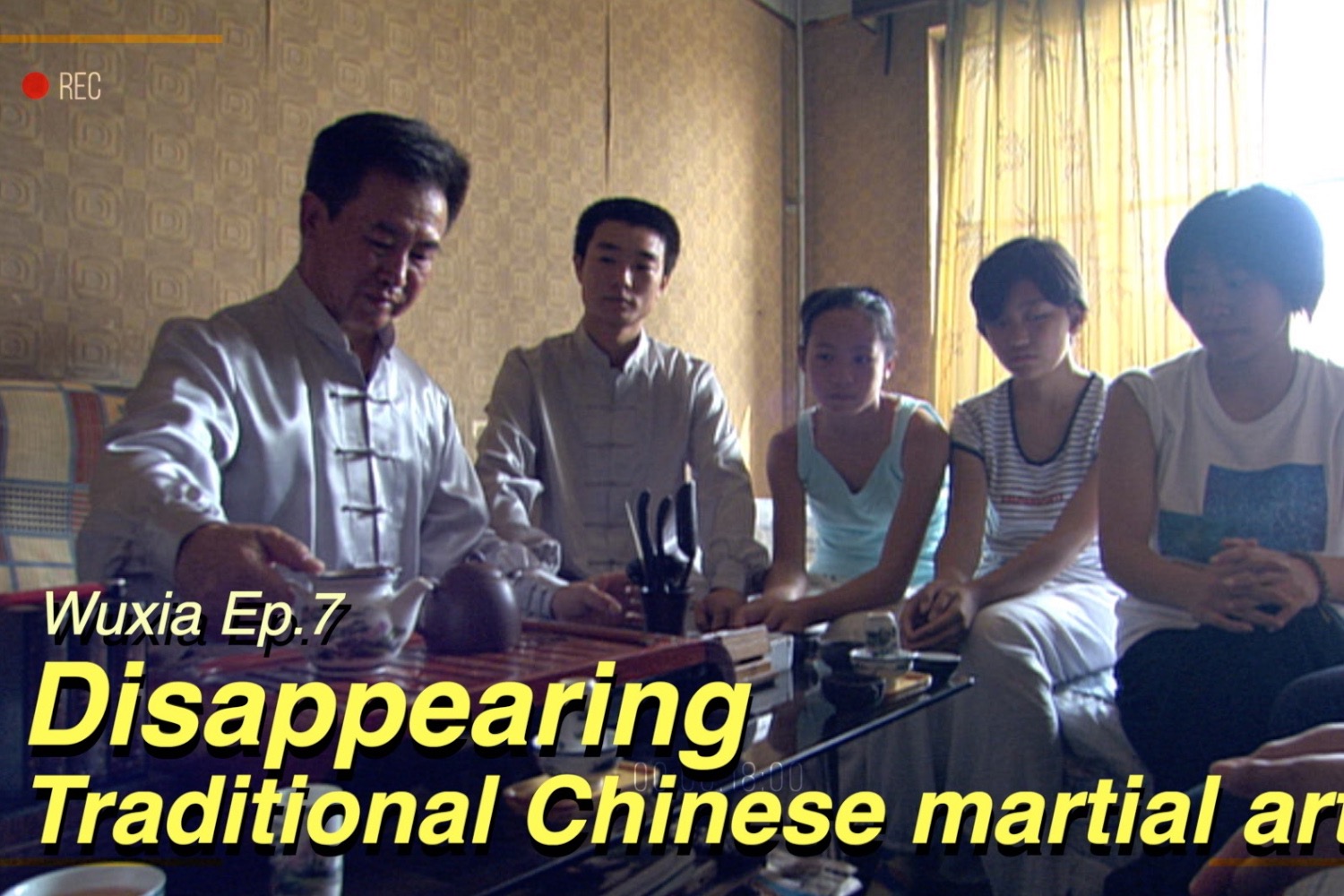생활 속의 무술(武術)
무협(武俠) 7화
[급변하는 중국의 전통 무술]
= 태권도 붐
- 상하이시 전경
하지만 사실 요즘 중국 젊은이들은 서양 스포츠나 외국 무술에 더 관심이 많다.
상하이에서 중류층 이상이 사는 아파트촌.
- 태권도 수련 모습
이곳에서는 최근 태권도 붐이 일고 있다.
수련비가 다른 무술 도장에 비해 훨씬 비싸지만 수련생은 백명이 넘는다.
- 태권도 수련생 인터뷰
(태권도는 운동이며 정신건강에 도움이 된다.
격정을 지니고 있고 리듬감이 있어 태권도가 좋다.
태권도는 예의뿐 아니라 몸매를 잘 가꿔준다.)
- 태권도장 ‘블랙벨트’ 홍보물
상하이에는 여기 말고도 사설 태권도 도장이 3곳이 더 있다.
태권도 클럽도 40여개에 이른다.
1988년 서울올림픽과 한류열풍의 영향이다.
- 태권도 수련 모습
하지만 무엇보다도 이들을 태권도 도장으로 이끄는 것은 깨끗하고 현대적인 도장 시설과 분위기다.
= 사라져가는 전통무술
- 매화장(梅花樁) 아파트 공터 전수
반면 전통무술은 제대로 된 도장을 찾아보기 힘들다.
수운강(隨云江)씨는 아파트 주차장에서 제자들에게 매화장(梅花樁)을 가르친다.
민간 전통 무술에 대한 중국 정부의 지원은 거의 없다.
- 서민 아파트 외경
- 차 대접하는 수운강(隨云江 쑤이윈장) 사범
쑤이윈장씨의 수련생은 여덟명 남짓.
따로 수련비는 정해져 있지 않다.
학생들은 각자 형편 되는대로 부식이나 약간의 돈을 가져온다.
-수운강(隨云江) 인터뷰
(일이 없습니다. 생활비도 없습니다.
이런 식으로 살아남은 무술 스승은 그 수가 적을 수밖에 없습니다.
지금 비록 안타깝기는 하지만 학생들에게 내게 무술을 배우러 오지 말라고 말할 수도 없습니다.)
- 담배피는 모습
천년 이상을 이어온 매화장(梅花樁)의 전통.
하지만 정부와 사회의 무관심 속에서 힘겹게, 그 맥을 이어가고 있다.
= 태극권(太極拳), 문화상품으로 도약 준비
- 진정뢰(陳正雷) 태극검술((太極劍術) 시범
다른 전통 무술과 달리 태극권(太極拳)은 힘찬 도약을 하고 있다.진식태극권(太極拳) 진가구(陳家溝) 11대 전수자로 중국 10대 무술명인에 들어가는 태극권(太極拳)의 고수, 진정뢰(陳正雷)씨.
그는 태극권(太極拳)을 중국의 문화상품으로 개발해서 전세계에 보급하려는 야심찬 계획을 추진이다.
- 진정뢰(陳正雷) 인터뷰
(30개가 넘는 나라를 돌아다녀 보니 내가 가르친 학생들이 전세계 60여개국에 퍼져있다. 이렇게 많은 나라를 돌아다녀서 얻은 느낌은 새롭다.
지금은 중국의 우수한 문화인 태극권(太極拳)의 사업화를 추진하고 있다.
이를 거대한 사업으로 삼을 방침이다. 거대한 문화로 발전시킬 것이다.)
- 세미나 후 가르치고 배우는 모습
현재 진가구(陳家溝) 태극권(太極拳)은 영어, 일어, 스페인어 등 8개국의 언어로 번역, 출판돼 있다.
전세계에 배포할 DVD 제작도 진행 중에 있다.
4백년 전 진가구(陳家溝) 라는 작은 시골 마을에서 시작된 태극권(太極拳)은 지금 세계인의 무술로 도약할 준비에 한창이다.
2003 documentary
Martial Arts in Life
Chinese Hero: Wuxia Ep.7
[Traditional Chinese martial arts that change rapidly ]
= Taekwondo boom
- Shanghai city view
But in fact, young Chinese these days are more interested in
Western sports and foreign martial arts.
An apartment village in Shanghai where the upper-middle class lives.
- Taekwondo training
Taekwondo is booming here.
The training fee is much higher than other martial arts studios,
but there are more than 100 trainees.
- Interview with Taekwondo trainees
(Taekwondo is an exercise and is beneficial for mental health.
Taekwondo is good because it has passion and a sense of rhythm.
Taekwondo is not only polite but also takes care of your body.)
- Taekwondo studio 'Black Belt' promotional material
There are three more private Taekwondo studios in Shanghai.
There are more than 40 Taekwondo clubs.
It is the influence of the 1988 Seoul Olympics and the Korean Wave.
- Taekwondo training
But most of all, it is the clean and modern studio facilities and atmosphere
that lead them to the Taekwondo dojo.
= Disappearing traditional martial arts
- Mui Fa Zong training
On the other hand, it is difficult to find a proper dojo for traditional martial arts.
Sui Yunjiang (隨云江), teaches Mui Fa Zong (梅花樁) to his students
in the parking lot of his apartment.
There is little support from the Chinese government for folk traditional martial arts.
- Outside view of common people's apartments
- Master Sui Yunjiang serving tea
Sui Yunjiang has only eight trainees.
There is no set training fee.
Students bring their own food or a small amount of money if they can afford it.
-Interview with Sui Yunjiang
(No work. No living expenses.
Martial arts teachers who have survived in this way are bound to be few.
Now, although I am sorry, I cannot tell my students not to come to learn martial arts.)
- Smoking
A tradition of Mui Fa Zong that has been passed down
for more than a thousand years.
However, in the indifference of the government and society,
it is struggling to keep up.
= Tai Chi, ready to take off as a cultural product
- Demonstration of Tai Chi swordsmanship
Unlike other traditional martial arts, Tai Chi is taking a powerful leap forward.
Chenjiagou 11th instructor and master of Tai Chi,
one of China's top 10 martial arts masters.
He is promoting an ambitious plan to develop Tai Chi
as a Chinese cultural product and distribute it to the world.
- Interview with Chen-roe
(I have traveled to more than 30 countries, and the students I have taught
are spread out in more than 60 countries around the world.
The feeling I get from traveling to so many countries is new.
Now, we are promoting the commercialization of Taijiqua,
an excellent culture in China.
We plan to make this a huge undertaking.
It will develop into a huge culture.)
- Teaching and learning after the seminar
Currently, Tai Chi has been translated and published in eight languages,
including English, Japanese, and Spanish.
DVD production for worldwide distribution is also in progress.
Tai Chi, which started in a small rural village called Chenjiagou 400 years ago,
is now preparing to leap forward as a global martial art.







